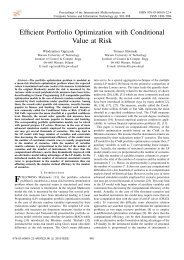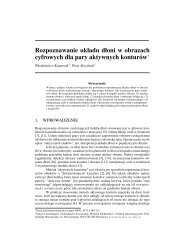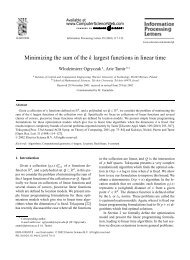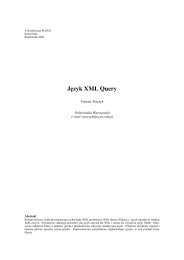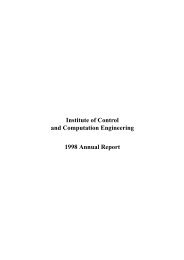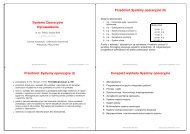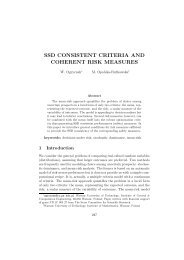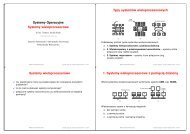Twenty Years of Linear Programming Based Portfolio Optimization
Twenty Years of Linear Programming Based Portfolio Optimization
Twenty Years of Linear Programming Based Portfolio Optimization
You also want an ePaper? Increase the reach of your titles
YUMPU automatically turns print PDFs into web optimized ePapers that Google loves.
528 R. Mansini et al. / European Journal <strong>of</strong> Operational Research 234 (2014) 518–535<br />
folio wealth so that the portfolio weights are defined in terms <strong>of</strong><br />
such fractions and the integer number <strong>of</strong> lots. Budget constraint<br />
is made ‘elastic’ using undershoot and overshoot variables, <br />
and + , respectively, which are penalized in the objective function<br />
with a high cost, c. In an optimum solution and + are made as<br />
small as possible so that the fractional holdings x i sum to a value as<br />
close as possible to 1.<br />
3. Cardinality constraint One basic implication <strong>of</strong> modern portfolio<br />
theory is that investors hold well diversified portfolios. However,<br />
there is empirical evidence that individual investors typically<br />
hold only a small number <strong>of</strong> securities. Market<br />
imperfections such as fixed transaction costs provide one <strong>of</strong><br />
the possible explanations for the selection <strong>of</strong> undiversified portfolios<br />
(see Wilding (2003)), but frequently the need to avoid<br />
costs <strong>of</strong> monitoring and <strong>of</strong> portfolio re-weighting leads investors<br />
to the common practice <strong>of</strong> limiting the number <strong>of</strong> securities<br />
(portfolio cardinality) that can be selected in a portfolio.<br />
Cardinality constraint can be expressed either as a strict equality<br />
or as an inequality imposing that the number <strong>of</strong> selected<br />
securities cannot be larger than a predefined number k<br />
X n<br />
j¼1<br />
z j 6 k;<br />
ð57Þ<br />
and is usually associated with threshold constraints to correctly<br />
enforce the value <strong>of</strong> binary variables.<br />
Many works both on mean variance approach and on linear<br />
risk/safety measures have been presented in the literature<br />
dealing with cardinality constraint portfolio optimization. In<br />
Chang et al. (2000) the authors extend the relative mean–<br />
variance model to include the cardinality constraint. The<br />
same model was previously studied by Bienstock (1996).<br />
Mean–variance models with the cardinality constraint are<br />
presented in Jobst et al. (2001) and Liu and Stefek (1995),<br />
in Lee and Mitchell (1997), inLi, Sun, and Wang (2006), in<br />
Fieldsend, Matatko, and Peng (2004) and many others (see<br />
Table 3). All these models are relative. <strong>Linear</strong> models including<br />
cardinality constraint are proposed by Speranza (1996)<br />
and by Angelelli et al. (2008), Angelelli, Mansini, and Speranza<br />
(2012) and are all absolute models. In Sankaran and<br />
Patil (1999) Sankaran and Patil introduce the cardinality constraint<br />
into an absolute model. Finally, in Anagnostopoulos<br />
and Mamanis (2010) cardinality constraint is directly minimized<br />
as an objective function.<br />
4. Investment threshold constraints These constraints define lower<br />
and upper limits on the proportion/amount <strong>of</strong> each asset held<br />
in the portfolio. They may model institutional restrictions on<br />
the composition <strong>of</strong> the portfolio and usually are used to rule<br />
out negligible holdings <strong>of</strong> asset in the portfolio, thus making<br />
its control easier.<br />
If the constraint is on a single security it is commonly formulated<br />
as:<br />
l j 6 x j 6 u j<br />
in relative models, and as<br />
L j 6 X j 6 U j<br />
ð58Þ<br />
ð59Þ<br />
in absolute models, where l j (u j ) and L j (U j ) are the lower (upper)<br />
bounds on the investment in security j, the former expressed in percentage,<br />
the latter in amount <strong>of</strong> capital. When such constraints are<br />
generalized to all the securities they are modeled using binary variables.<br />
In general, it may happen that a single security or a little diversified<br />
portfolio is SSD dominating over all other (more diversified) portfolios,<br />
and the SSD consistent Markowitz-type models will select such<br />
an undiversified solution. Especially, the SSD consistent models<br />
based on the LP computable risk measures may fail to generate sufficiently<br />
diversified portfolios. Therefore, additional restrictions<br />
may be set on the feasible portfolios to guarantee the required<br />
diversification. The simplest way to enforce portfolio diversification<br />
is to limit the maximum share as in (58) and (59). This, however,<br />
may result in a portfolio with a few equal shares depending on<br />
the value set to the maximum share. A better modeling alternative<br />
would be to allow for a relatively large maximum share provided<br />
that the other shares are smaller. Such a rich diversification scheme<br />
may be introduced with the CVaR constructs applied to the right tail<br />
<strong>of</strong> the distribution <strong>of</strong> shares (see Mansini et al. (2007) for a detail<br />
description). In particular, any model under consideration can easily<br />
be extended with direct diversification constraints specified as<br />
follows:<br />
ks k þ Xn<br />
d s kj 6 c k and ds kj 6 x j s k ; d s kj P 0 j<br />
j¼1<br />
¼ 1; ...; n;<br />
ð60Þ<br />
where s k is an unbounded variable (representing the kth largest<br />
share at the optimum), d s kj<br />
are additional nonnegative (deviational)<br />
variables, and c k is the upper bound on the total <strong>of</strong> the k largest<br />
shares.<br />
Finally, a lower and an upper bound on the investment may also refer<br />
to a set <strong>of</strong> securities instead than to a single one (class constraints).<br />
These are typical sector/industry constraints (see Chang<br />
et al. (2000) where they are only modeled and Anagnostopoulos &<br />
Mamanis (2010)). Let G s be a set <strong>of</strong> securities <strong>of</strong> the same sector s.<br />
A class constraint is, in relative models, formulated as follows:<br />
l s 6 X j2G s<br />
x j 6 u s ;<br />
ð61Þ<br />
where l s and u s are lower and upper bounds expressed as percentage<br />
on the total unitary investment available for securities belonging<br />
to sector s. Similarly, in the case <strong>of</strong> absolute models, with the X’s<br />
instead <strong>of</strong> the x’s and the constants that represent amounts.<br />
It is worth noticing that all references reported in Table 3 for cardinality<br />
constraints and fixed costs also include threshold constraints<br />
typically used to enforce binary variables z j value. Thus, threshold<br />
bounds only refer to contributions where lower and upper bounds<br />
are the only real feature introduced or where investment bounds<br />
(especially upper bounds) are modeled without the use <strong>of</strong> binary<br />
variables.<br />
5. Decision dependency constraints Decision dependency requirements<br />
are common in financial dealings. To be correctly modeled,<br />
they need the binary variables z j already described.<br />
Usually they take one <strong>of</strong> the following forms:<br />
Both securities i and j have to belong to the portfolio if security<br />
k is selected (joint investment):<br />
z i þ z j P 2z k :<br />
ð62Þ<br />
Stock i cannot be selected if security j is in the portfolio (mutually<br />
exclusive investment):<br />
z i þ z j 6 1:<br />
ð63Þ<br />
Security i can be selected only if security j is in the portfolio (contingent<br />
investment):<br />
z i 6 z j :<br />
ð64Þ<br />
Combinations <strong>of</strong> these conditions are also possible, resulting in<br />
more complex relationships. These investment restrictions can be




